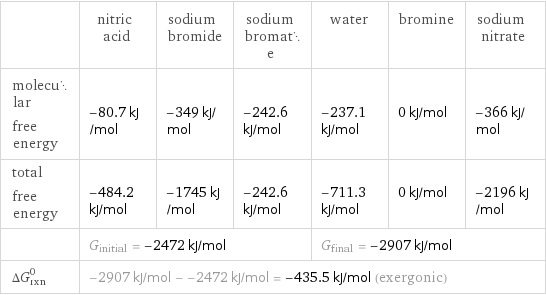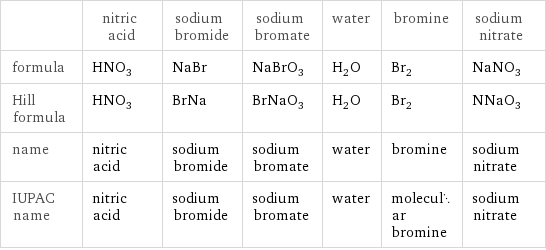Input interpretation

HNO_3 nitric acid + NaBr sodium bromide + NaBrO_3 sodium bromate ⟶ H_2O water + Br_2 bromine + NaNO_3 sodium nitrate
Balanced equation

Balance the chemical equation algebraically: HNO_3 + NaBr + NaBrO_3 ⟶ H_2O + Br_2 + NaNO_3 Add stoichiometric coefficients, c_i, to the reactants and products: c_1 HNO_3 + c_2 NaBr + c_3 NaBrO_3 ⟶ c_4 H_2O + c_5 Br_2 + c_6 NaNO_3 Set the number of atoms in the reactants equal to the number of atoms in the products for H, N, O, Br and Na: H: | c_1 = 2 c_4 N: | c_1 = c_6 O: | 3 c_1 + 3 c_3 = c_4 + 3 c_6 Br: | c_2 + c_3 = 2 c_5 Na: | c_2 + c_3 = c_6 Since the coefficients are relative quantities and underdetermined, choose a coefficient to set arbitrarily. To keep the coefficients small, the arbitrary value is ordinarily one. For instance, set c_3 = 1 and solve the system of equations for the remaining coefficients: c_1 = 6 c_2 = 5 c_3 = 1 c_4 = 3 c_5 = 3 c_6 = 6 Substitute the coefficients into the chemical reaction to obtain the balanced equation: Answer: | | 6 HNO_3 + 5 NaBr + NaBrO_3 ⟶ 3 H_2O + 3 Br_2 + 6 NaNO_3
Structures

+ + ⟶ + +
Names

nitric acid + sodium bromide + sodium bromate ⟶ water + bromine + sodium nitrate
Reaction thermodynamics
Gibbs free energy

| nitric acid | sodium bromide | sodium bromate | water | bromine | sodium nitrate molecular free energy | -80.7 kJ/mol | -349 kJ/mol | -242.6 kJ/mol | -237.1 kJ/mol | 0 kJ/mol | -366 kJ/mol total free energy | -484.2 kJ/mol | -1745 kJ/mol | -242.6 kJ/mol | -711.3 kJ/mol | 0 kJ/mol | -2196 kJ/mol | G_initial = -2472 kJ/mol | | | G_final = -2907 kJ/mol | | ΔG_rxn^0 | -2907 kJ/mol - -2472 kJ/mol = -435.5 kJ/mol (exergonic) | | | | |
Equilibrium constant
![Construct the equilibrium constant, K, expression for: HNO_3 + NaBr + NaBrO_3 ⟶ H_2O + Br_2 + NaNO_3 Plan: • Balance the chemical equation. • Determine the stoichiometric numbers. • Assemble the activity expression for each chemical species. • Use the activity expressions to build the equilibrium constant expression. Write the balanced chemical equation: 6 HNO_3 + 5 NaBr + NaBrO_3 ⟶ 3 H_2O + 3 Br_2 + 6 NaNO_3 Assign stoichiometric numbers, ν_i, using the stoichiometric coefficients, c_i, from the balanced chemical equation in the following manner: ν_i = -c_i for reactants and ν_i = c_i for products: chemical species | c_i | ν_i HNO_3 | 6 | -6 NaBr | 5 | -5 NaBrO_3 | 1 | -1 H_2O | 3 | 3 Br_2 | 3 | 3 NaNO_3 | 6 | 6 Assemble the activity expressions accounting for the state of matter and ν_i: chemical species | c_i | ν_i | activity expression HNO_3 | 6 | -6 | ([HNO3])^(-6) NaBr | 5 | -5 | ([NaBr])^(-5) NaBrO_3 | 1 | -1 | ([NaBrO3])^(-1) H_2O | 3 | 3 | ([H2O])^3 Br_2 | 3 | 3 | ([Br2])^3 NaNO_3 | 6 | 6 | ([NaNO3])^6 The equilibrium constant symbol in the concentration basis is: K_c Mulitply the activity expressions to arrive at the K_c expression: Answer: | | K_c = ([HNO3])^(-6) ([NaBr])^(-5) ([NaBrO3])^(-1) ([H2O])^3 ([Br2])^3 ([NaNO3])^6 = (([H2O])^3 ([Br2])^3 ([NaNO3])^6)/(([HNO3])^6 ([NaBr])^5 [NaBrO3])](../image_source/6d37729b8f809ce9e9793274fd0c5843.png)
Construct the equilibrium constant, K, expression for: HNO_3 + NaBr + NaBrO_3 ⟶ H_2O + Br_2 + NaNO_3 Plan: • Balance the chemical equation. • Determine the stoichiometric numbers. • Assemble the activity expression for each chemical species. • Use the activity expressions to build the equilibrium constant expression. Write the balanced chemical equation: 6 HNO_3 + 5 NaBr + NaBrO_3 ⟶ 3 H_2O + 3 Br_2 + 6 NaNO_3 Assign stoichiometric numbers, ν_i, using the stoichiometric coefficients, c_i, from the balanced chemical equation in the following manner: ν_i = -c_i for reactants and ν_i = c_i for products: chemical species | c_i | ν_i HNO_3 | 6 | -6 NaBr | 5 | -5 NaBrO_3 | 1 | -1 H_2O | 3 | 3 Br_2 | 3 | 3 NaNO_3 | 6 | 6 Assemble the activity expressions accounting for the state of matter and ν_i: chemical species | c_i | ν_i | activity expression HNO_3 | 6 | -6 | ([HNO3])^(-6) NaBr | 5 | -5 | ([NaBr])^(-5) NaBrO_3 | 1 | -1 | ([NaBrO3])^(-1) H_2O | 3 | 3 | ([H2O])^3 Br_2 | 3 | 3 | ([Br2])^3 NaNO_3 | 6 | 6 | ([NaNO3])^6 The equilibrium constant symbol in the concentration basis is: K_c Mulitply the activity expressions to arrive at the K_c expression: Answer: | | K_c = ([HNO3])^(-6) ([NaBr])^(-5) ([NaBrO3])^(-1) ([H2O])^3 ([Br2])^3 ([NaNO3])^6 = (([H2O])^3 ([Br2])^3 ([NaNO3])^6)/(([HNO3])^6 ([NaBr])^5 [NaBrO3])
Rate of reaction
![Construct the rate of reaction expression for: HNO_3 + NaBr + NaBrO_3 ⟶ H_2O + Br_2 + NaNO_3 Plan: • Balance the chemical equation. • Determine the stoichiometric numbers. • Assemble the rate term for each chemical species. • Write the rate of reaction expression. Write the balanced chemical equation: 6 HNO_3 + 5 NaBr + NaBrO_3 ⟶ 3 H_2O + 3 Br_2 + 6 NaNO_3 Assign stoichiometric numbers, ν_i, using the stoichiometric coefficients, c_i, from the balanced chemical equation in the following manner: ν_i = -c_i for reactants and ν_i = c_i for products: chemical species | c_i | ν_i HNO_3 | 6 | -6 NaBr | 5 | -5 NaBrO_3 | 1 | -1 H_2O | 3 | 3 Br_2 | 3 | 3 NaNO_3 | 6 | 6 The rate term for each chemical species, B_i, is 1/ν_i(Δ[B_i])/(Δt) where [B_i] is the amount concentration and t is time: chemical species | c_i | ν_i | rate term HNO_3 | 6 | -6 | -1/6 (Δ[HNO3])/(Δt) NaBr | 5 | -5 | -1/5 (Δ[NaBr])/(Δt) NaBrO_3 | 1 | -1 | -(Δ[NaBrO3])/(Δt) H_2O | 3 | 3 | 1/3 (Δ[H2O])/(Δt) Br_2 | 3 | 3 | 1/3 (Δ[Br2])/(Δt) NaNO_3 | 6 | 6 | 1/6 (Δ[NaNO3])/(Δt) (for infinitesimal rate of change, replace Δ with d) Set the rate terms equal to each other to arrive at the rate expression: Answer: | | rate = -1/6 (Δ[HNO3])/(Δt) = -1/5 (Δ[NaBr])/(Δt) = -(Δ[NaBrO3])/(Δt) = 1/3 (Δ[H2O])/(Δt) = 1/3 (Δ[Br2])/(Δt) = 1/6 (Δ[NaNO3])/(Δt) (assuming constant volume and no accumulation of intermediates or side products)](../image_source/791f606df88a2804cbe57c7a84738e9a.png)
Construct the rate of reaction expression for: HNO_3 + NaBr + NaBrO_3 ⟶ H_2O + Br_2 + NaNO_3 Plan: • Balance the chemical equation. • Determine the stoichiometric numbers. • Assemble the rate term for each chemical species. • Write the rate of reaction expression. Write the balanced chemical equation: 6 HNO_3 + 5 NaBr + NaBrO_3 ⟶ 3 H_2O + 3 Br_2 + 6 NaNO_3 Assign stoichiometric numbers, ν_i, using the stoichiometric coefficients, c_i, from the balanced chemical equation in the following manner: ν_i = -c_i for reactants and ν_i = c_i for products: chemical species | c_i | ν_i HNO_3 | 6 | -6 NaBr | 5 | -5 NaBrO_3 | 1 | -1 H_2O | 3 | 3 Br_2 | 3 | 3 NaNO_3 | 6 | 6 The rate term for each chemical species, B_i, is 1/ν_i(Δ[B_i])/(Δt) where [B_i] is the amount concentration and t is time: chemical species | c_i | ν_i | rate term HNO_3 | 6 | -6 | -1/6 (Δ[HNO3])/(Δt) NaBr | 5 | -5 | -1/5 (Δ[NaBr])/(Δt) NaBrO_3 | 1 | -1 | -(Δ[NaBrO3])/(Δt) H_2O | 3 | 3 | 1/3 (Δ[H2O])/(Δt) Br_2 | 3 | 3 | 1/3 (Δ[Br2])/(Δt) NaNO_3 | 6 | 6 | 1/6 (Δ[NaNO3])/(Δt) (for infinitesimal rate of change, replace Δ with d) Set the rate terms equal to each other to arrive at the rate expression: Answer: | | rate = -1/6 (Δ[HNO3])/(Δt) = -1/5 (Δ[NaBr])/(Δt) = -(Δ[NaBrO3])/(Δt) = 1/3 (Δ[H2O])/(Δt) = 1/3 (Δ[Br2])/(Δt) = 1/6 (Δ[NaNO3])/(Δt) (assuming constant volume and no accumulation of intermediates or side products)
Chemical names and formulas

| nitric acid | sodium bromide | sodium bromate | water | bromine | sodium nitrate formula | HNO_3 | NaBr | NaBrO_3 | H_2O | Br_2 | NaNO_3 Hill formula | HNO_3 | BrNa | BrNaO_3 | H_2O | Br_2 | NNaO_3 name | nitric acid | sodium bromide | sodium bromate | water | bromine | sodium nitrate IUPAC name | nitric acid | sodium bromide | sodium bromate | water | molecular bromine | sodium nitrate
Substance properties

| nitric acid | sodium bromide | sodium bromate | water | bromine | sodium nitrate molar mass | 63.012 g/mol | 102.89 g/mol | 150.89 g/mol | 18.015 g/mol | 159.81 g/mol | 84.994 g/mol phase | liquid (at STP) | solid (at STP) | solid (at STP) | liquid (at STP) | liquid (at STP) | solid (at STP) melting point | -41.6 °C | 755 °C | 381 °C | 0 °C | -7.2 °C | 306 °C boiling point | 83 °C | 1396 °C | 1390 °C | 99.9839 °C | 58.8 °C | density | 1.5129 g/cm^3 | 3.2 g/cm^3 | 3.339 g/cm^3 | 1 g/cm^3 | 3.119 g/cm^3 | 2.26 g/cm^3 solubility in water | miscible | soluble | soluble | | insoluble | soluble surface tension | | | | 0.0728 N/m | 0.0409 N/m | dynamic viscosity | 7.6×10^-4 Pa s (at 25 °C) | | | 8.9×10^-4 Pa s (at 25 °C) | 9.44×10^-4 Pa s (at 25 °C) | 0.003 Pa s (at 250 °C) odor | | | odorless | odorless | |
Units
